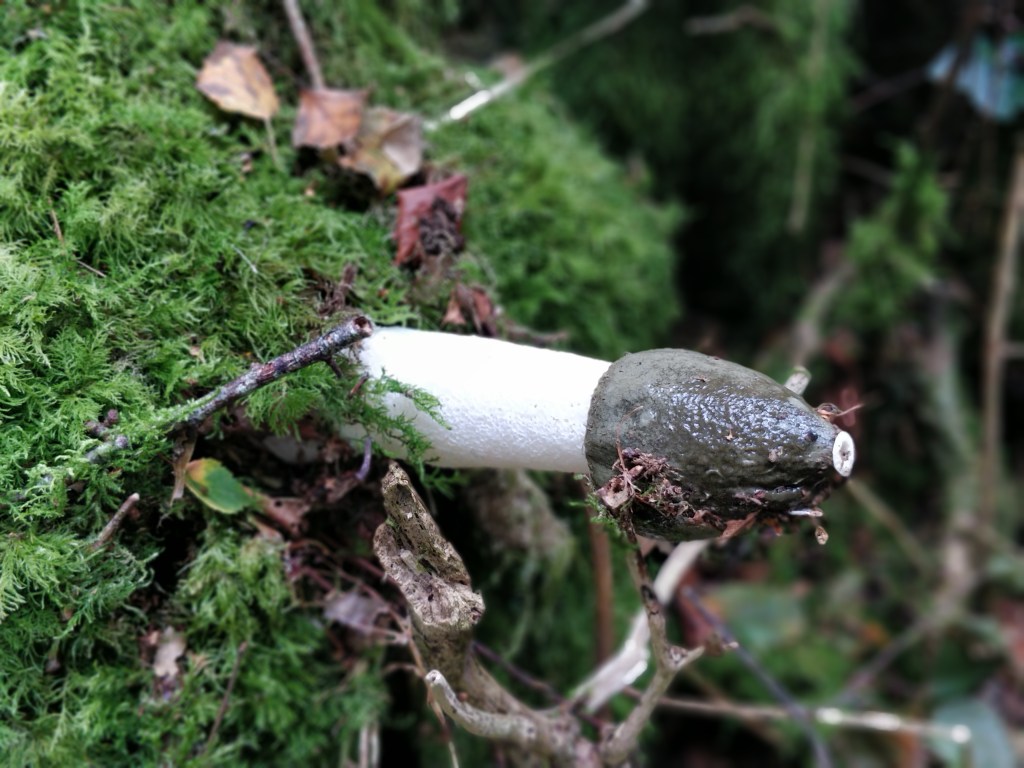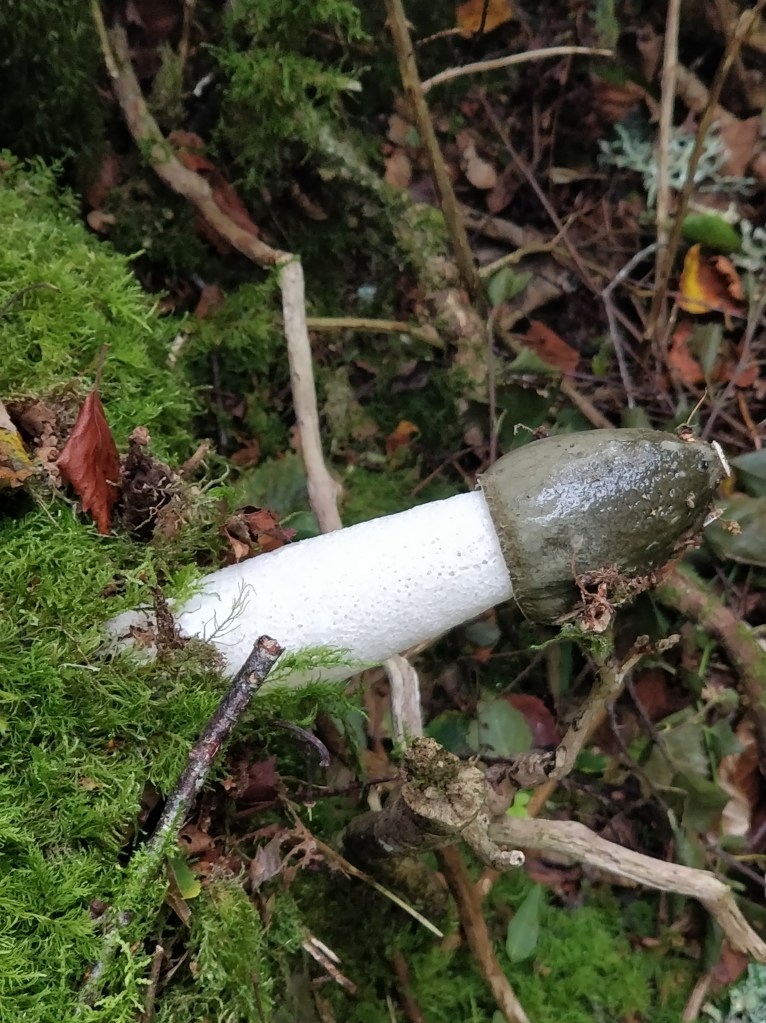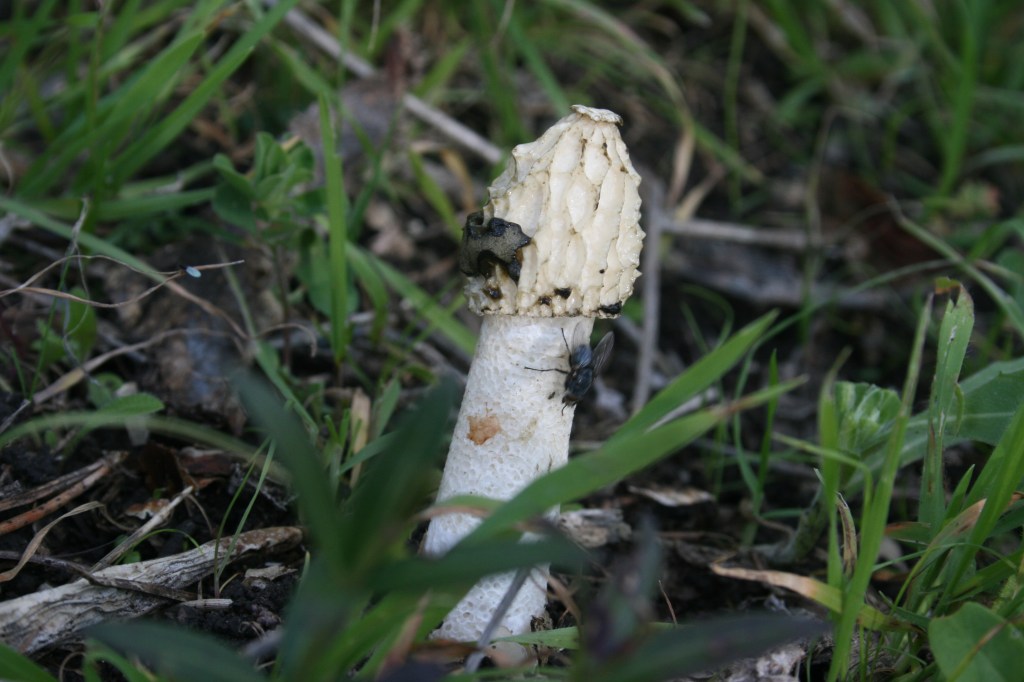
I love how diverse the forms of fungi can be, and this is (probably – apart from its very similar brother P. hadriani) the rudest looking fungus in the west, sure to illicit scoffs and giggles when seen. This delightfully protruding formation is the common stinkhorn.
It first emerges from the ground as egg shaped, and at this immature stage they are eaten as a delicacy – although apparently still emit a pungent smell at this stage thought not quite as strong as the mature form. As they break out of the egg stage the tip can be seen covered in the green-ish brown ‘gleba’ which contains the spores. Flies are attracted to this whiffy, sticky substance, landing on it and consuming it, sticking the spores to their feet and spreading the spores when they fly on their merry way.

The stem is white, spongey and hollow, it tapers towards the top which has a dome that is covered with the slimey gleba. The smell is described in various terms such as like ‘bad drains’, ‘rotting flesh’, ‘faeces’, ‘foul’ and politely as ‘unpleasant’. Funnily, (luckily?) enough, I have a very poor sense of smell, and I haven’t experienced the smell first hand, despite my finds.

My first was in December 2015 in rural Sicily, land that had eucalyptus, pine and Agave and Opuntia ficus-indica (Pricky pear) on the grounds. It was in December and the gleba was almost entirely decimated aside from a patch on the side, a fly was hanging out around it for quite a while. Second find was in tact protruding from the side of a pine tree in County Wicklow, Ireland.
They are known to be found in soil, woodland, gardens and on stumps of both broadleaved and coniferous trees, in Ireland and the UK from early summer to autumn. They are saprobic, which means they live on dead wood.
There are 6225 records of P. impudicus in the UK on Cate2, 71 of P. hadriani and 3 of P. duplicatus, which is very similar but has a net veil hanging from its cap. 87 records of P. impudicus on the Biodata Centre for Ireland, spread across the country, high concentrations of records in Dublin, but as usual I suspect this doesn’t necessarily reflect the prevalence of the species, rather, a concentration of recorders and their sometime tendency to grow in groups, though they can also grow on their own! They are spread across Europe and North America too.
Basic Profile
Scientific name: Phallus impudicus
Common names: Common stinkhorn
Size of fruiting body: cm tall, cm wide
Spores: ellipsoid 3.5-4 x 1.5-2 µm
Gills: None!
Edibility: Edible, apparently, at egg stage. Nicknamed ‘witches egg’, still stinks so not necessarily appetising!
Lookalikes: Phallus hadriani – shorter and only grows on sand dunes in Britain, grows from a pink ‘egg’ rather than white; Mutinus caninus – Dog stinkhorn – stipe is yellow and altogether different proportions
On the Red Data List (extinct/critically endangered/endangered/vulnerable/near threatened): No
References:
Cate2 Database, managed and maintained by The Fungus Conservation Trust
National Biodiversity Data Centre
Rude, erect and smothered in flies, this fungus has no shame, Paul Evans, The Guardian,
Red Data List, British Mycological Society
http://iucn.ekoo.se/, The Global Fungal Red List Initiative
Collins Complete Guide to British Mushrooms & Toadstools, Paul Sterry & Barry Hughes, 2009
Mushrooms and Toadstools of Britain and Europe, Edmund Garnweidner, 1994
Mushrooms, Patrick Hardy, 2013
The Encyclopedia of Fungi of Britain and Europe, Michael Jordan, 2004
